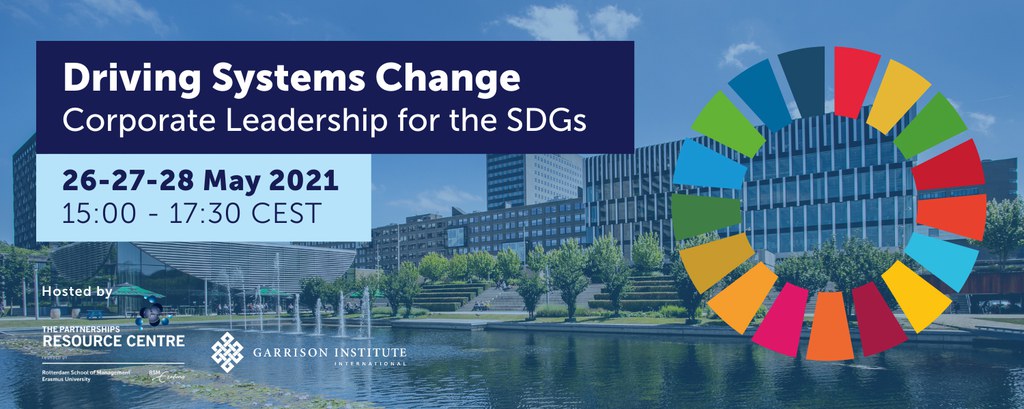27 May 2021
16.45 - 17.30
Once you have registered, you can add our workshop to your own agenda: Google Calender (for other options, access the conference's program)
How can corporate business models be linked to relevant SDG-indicators? WageIndicator shows how the implementation of Living Wages can be a strategic choice.
On Thursday 27 May, WageIndicator will host a workshop on the role of its Living Wage Database for achieving the Sustainable Developments Goals (SDGs), during the free, online conference Driving Systems Change - Corporate Leadership for the SDGs.
Next to WageIndicator's director Paulien Osse and co-creator of the Living Wage Database Martin Kahanec, several spokespersons of multinationals will talk about how they are using the Living Wage Database. The Dutch Social and Economic Council will reflect on the presentations.
Check out the conference's program
Introduction |
|
|
Paulien Osse |
Introductory statement by Paulien Osse, Director of the WageIndicator Foundation: Living Wage is the linking pin of at least 5 SDGs |
Video presentation
presentation |
|||
|
Laura Garcia |
Bogdan Pode |
Simon Braaksma |
|
|
Presentations by multinationals: How can you use Living Wages to reach Sustainable Development Goals? GLOVO: Laura GarciaLaura is currently leading several projects related to the Courier Experience at Glovo. Glovo is a multi-category delivery platform connecting businesses, users and couriers with presence in more than 20 countries, from Spain to Kenya. The Courier Experience team acts as an ambassador of the couriers voice within the company. IKEA: Bogdan PodeBogdan is currently leading the development of Responsible Wage Practices - a multi-stakeholders and multidisciplinary assignment that addresses the whole IKEA system (Inter IKEA Group – IKEA Franchisees - Suppliers) with the aim to deliver a common IKEA approach and standpoint encompassing all the different views on the topic. Philips: Simon BraaksmaAfter obtaining his MBA, Simon started his career in 1990 with Citibank where he worked in different management positions until he moved to Philips' Treasury Group in 1998. Next, he worked on a finance transformation project and in Group Control before joining Group Sustainability some 13 years ago where he is responsible for Philips' sustainability reporting, contacts with ESG investors and Philips' climate strategy. |
|||
Reflection |
|
|
Katrien Termeer |
Reflection by Katrien Termeer, deputy Crown member for the Dutch Social and Economic Council (SER). Prof. Dr. ir. C.J.A.M. Termeer chairs also the Public Administration and Policy Group of WUR, Wageningen, University & Research. Picture by Christiaan Krouwels |
Moderator |
|
|
Martin Kahanec |
This workshop will be moderated by Martin Kahanec. Kahanec is the Dean (2020-21) of the School of Public Policy at the Central European University in Vienna and co-creator of the WageIndicator Living Wage database. |
Background Information
What are Sustainable Development Goals?
There are 17 Sustainable Development Goals, proclaimed by the United Nations on September 25, 2015. These goals are to be achieved by 2030. Each SDG has global outreach. The SDGs have been elaborated as 169 sub-targets for which more than 230 key SDG-indicators were agreed upon (official list published June 2016).
Examples of key SDG-indicators
1.2.2 Proportion of men, women and children of all ages living in poverty in all its dimensions according to national definitions. (SDG 1 No Poverty)
8.5.1 Average hourly earnings of female and male employees, by occupation, age and persons with disabilities. (SDG 8 Decent Work and Economic Growth)
10.2.1 Proportion of people living below 50 per cent of median income, by age, sex and persons with disabilities. (SDG 10 Reduced Inequalities)
Something was felt to be lacking
Of all 230 indicators identified and agreed upon, these few mentioned above are the most concrete when it comes to measuring progress in reaching ’theír’ SDGs. The response of - especially - multinational corporations since 2016, has made clear that these indicators do not answer their practical needs sufficiently. And quite understandably so. For instance, the full list of indicators does not once mention very obvious instruments to measure poverty (SDG 1), decent work and economic growth (SDG 8) and reduced inequalities (SDG 10), such as minimum wages, Living Wages, equal pay for men and women. These would have seemed to be proper candidate tools for inclusion, since they are made up of telling figures, and - if updated regularly - fit for measuring trends.
In particular the search for sustainable Living Wage benchmarks took off on a global scale. And since WageIndicator over the past 6 years (since 2014) developed such a global benchmark system, multinational corporations increasingly made the connection. Today a few dozen already are paying customers of WageIndicator, implementing its data in their remuneration policies worldwide. WageIndicator is proud to welcome some of them in its workshop during the Symposium Corporate Leadership for the SDGs. But why Living Wages suddenly became the focus?
Living Wages are a strategic choice
The overall answer is: because Living Wage is a strategically placed remuneration tool, implementation of which immediately impacts 5 SDGs. Some keen observers claim an even larger number of affected SDGs. Take for instance the analysis of the British-based Living Wage Foundation. It starts from the position taken by the UNDP, which says that poverty eradication is only possible through stable and well-paid jobs. This is where Living Wage becomes key. A Living Wage means the difference between mere subsistence and the ability to meet basic needs and have a modest amount left over to enhance well-being and physical and mental health. A Living Wage can free people from personal debt, help to pay for the education of their children or to save for their own security in later life. Paying people a Living Wage also underpins many of the wider ambitions represented in the SDGs, such as good health and wellbeing, quality education and gender equality. The Living Wage is crucial to 8 of the 17 SDGs, the Living Wage Foundation holds.
This argument makes it easy to understand why Living Wages-data should be in great demand as a corporate response to SDG-commitment. Companies which pay Living Wages thereby make a decent life for their workers possible. Because a decent income makes for stable family life in communities with the means to invest in themselves and prosper, fostering society in which people have a chance to grow up and develop harmoniously. A master move would certainly be to pay working mothers a Living Wage. This would eradicate socio-economic gender inequality at one stroke and boost mothers’ say in sending their kids to school, their daughters in particular, etc. etc. A healthy cycle sets in, well documented on a global scale.
SDGs that WageIndicator may help to achieve with its data
Some of the 17 SDGs interface/overlap with what WageIndicator does. In descending order of relevance these SDGs seem to be:
- SDG 8: Decent Work and Economic Growth
- SDG 1: No Poverty
- SDG 3: Good Health and Well-Being
- SDG 5: Gender Equality
- SDG 10: Reduced Inequality
- SDG 16: Peace, Justice and Strong Institutions
From this helicopter view it looks like relevant WageIndicator benchmark contributions are not just its Living Wage database, but also its Decent Work Check (Labour Law database), in conjunction with its Minimum Wage database. All on a global scale, internationally comparable, as well as regularly updated.
SDG-indicator flaws WageIndicator has overcome
Rob van Tulder (Business & the Sustainable Development Goals, A Framework for Effective Corporate Involvement, Rotterdam, 2018, p. 45, 46) identifies problem areas pervading the SDG-indicators. Presented below, these are followed by the ways in which WageIndicator overcame them.
- Ambiguous definitions: The definitions (and methodology) WageIndicator uses in its research are identical in all countries and laid down in its published research manual.
- Macro-bias: WageIndicator survey data is collected from individuals, hence consists of micro-data by nature; national labor law and minimum wage data is rooted in de jure rules and regulations.
- Dependence on governments’ data contributions: WageIndicator is an NGO. It collects data from individuals and public sources.
- Missing indicators: WageIndicator - partially - fills this gap.
- Selection of indicator-data may be politically motivated: WageIndicator is (and must be) non-political to guarantee its reliability as an unbiased source.
- Indicators are difficult to quantify: Quantification of data is what WageIndicator specializes in and has proven to be good at.
- Difficulties in comparing countries: WageIndicator operates similarly in all countries around the globe in order to ensure comparability and compatibility of its data.








